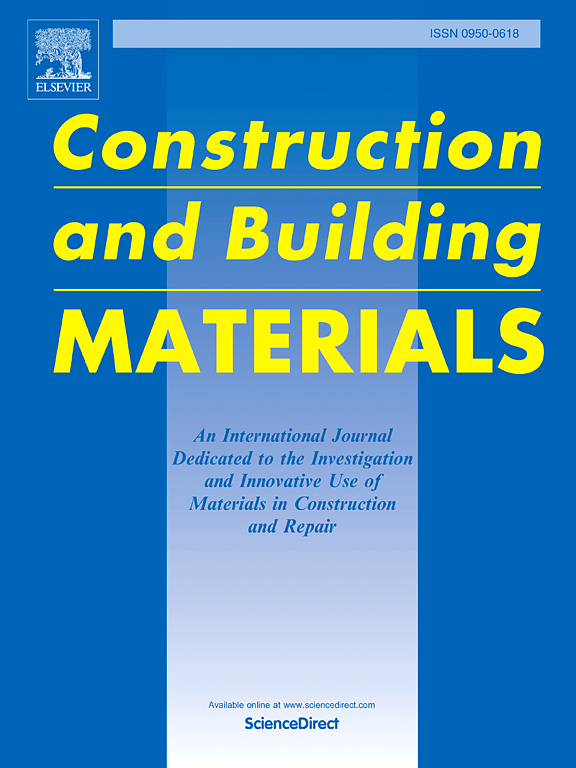磷石膏和铝箔废料可持续合成钙矾石:表征和Rietveld细化分析
IF 8
1区 工程技术
Q1 CONSTRUCTION & BUILDING TECHNOLOGY
引用次数: 0
摘要
磷肥对于维持全球农业生产力和确保不断增长的人口的粮食安全至关重要。然而,它们的生产产生了大量的磷石膏,这是一种对环境构成重大挑战的副产品。本研究通过探索磷石膏转化为钙矾石这一在水泥化学和环境修复中具有广泛应用价值的材料,解决了有效管理磷石膏废物的迫切需要。本研究的主要目的是通过控制共沉淀过程,开发一种经济有效的合成途径,将磷石膏转化为钙矾石。通过调节盐酸浓度和温度等关键参数,对磷石膏的溶解进行了系统优化。结果表明,在60℃条件下,2 M HCl的溶解度较高,反应效率较高。在此条件下,使用固定质量的2.5 g磷石膏和0.2 g废铝,保持Ca/Al摩尔比为2,可以控制钙矾石的沉淀。利用x射线衍射(XRD)、傅里叶变换红外光谱(FTIR)、x射线荧光(XRF)、扫描电镜(SEM)和能量色散x射线(EDX)对合成材料进行了全面表征,证实了合成材料的相组成、高结晶度和特征形貌。此外,Rietveld细化进行定量分析晶体结构和相纯度,确保形成一个明确的三角钙矾石结构。这种创新的方法有效地将磷石膏转化为一种有价值的材料,展示了其在废物增值和工业用途中可扩展和可持续应用的潜力。这种方法不仅减少了废物问题,而且有助于资源的可持续利用和循环经济的实践。本文章由计算机程序翻译,如有差异,请以英文原文为准。
Sustainable synthesis of ettringite from phosphogypsum and aluminum foil waste: Characterization and Rietveld refinement analysis
Phosphate fertilizers are essential for maintaining global agricultural productivity and ensuring food security for a growing population. However, their production generates substantial quantities of phosphogypsum, a byproduct that presents significant environmental challenges. This study addresses the pressing need for effective phosphogypsum waste management by exploring its conversion into ettringite, a valuable material with wide raging applications in cement chemistry and environmental remediation. The primary objective of this research was to develop a cost-effective synthesis pathway to transform phosphogypsum into ettringite through a controlled coprecipitation process. The dissolution of phosphogypsum was systematically optimized by adjusting key parameters, including the concentration of hydrochloric acid and temperature. The most effective condition was found to be 2 M HCl at 60 °C, which ensured high solubility and process efficiency. Under this condition, a fixed mass of 2.5 g of phosphogypsum was used along with 0.2 g of aluminum waste to maintain a Ca/Al molar ratio of 2, enabling controlled precipitation of ettringite. The synthesized material was thoroughly characterized using X-ray diffraction (XRD), Fourier transform infrared spectroscopy (FTIR), X-ray fluorescence (XRF), scanning electron microscopy (SEM), and energy-dispersive X-Ray (EDX), confirmed the phase composition, high crystallinity and characteristic morphology. Additionally, Rietveld refinement was performed to quantitatively analyze the crystalline structure and phase purity, ensuring the formation of a well-defined trigonal ettringite structure. This innovative approach effectively transformed phosphogypsum into a valuable material, demonstrating its potential for scalable and sustainable applications in waste valorization and industrial use. This approach not only reduces waste problems, but also contributes to the sustainable use of resources and circular economy practices.
求助全文
通过发布文献求助,成功后即可免费获取论文全文。
去求助
来源期刊

Construction and Building Materials
工程技术-材料科学:综合
CiteScore
13.80
自引率
21.60%
发文量
3632
审稿时长
82 days
期刊介绍:
Construction and Building Materials offers an international platform for sharing innovative and original research and development in the realm of construction and building materials, along with their practical applications in new projects and repair practices. The journal publishes a diverse array of pioneering research and application papers, detailing laboratory investigations and, to a limited extent, numerical analyses or reports on full-scale projects. Multi-part papers are discouraged.
Additionally, Construction and Building Materials features comprehensive case studies and insightful review articles that contribute to new insights in the field. Our focus is on papers related to construction materials, excluding those on structural engineering, geotechnics, and unbound highway layers. Covered materials and technologies encompass cement, concrete reinforcement, bricks and mortars, additives, corrosion technology, ceramics, timber, steel, polymers, glass fibers, recycled materials, bamboo, rammed earth, non-conventional building materials, bituminous materials, and applications in railway materials.
 求助内容:
求助内容: 应助结果提醒方式:
应助结果提醒方式:


